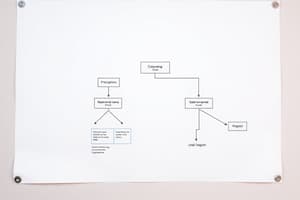Podcast
Questions and Answers
What can be the name of the participant in a sequence diagram?
What can be the name of the participant in a sequence diagram?
- Only execution occurrences
- Only a named instance is allowed
- An anonymous instance and a class (correct)
- A class only
What does the colon signify in a sequence diagram?
What does the colon signify in a sequence diagram?
- End of the message execution
- Separation of object name from class name (correct)
- Return message indication
- Start of the execution
In the sequence diagram provided, which method calls are made by class A?
In the sequence diagram provided, which method calls are made by class A?
- doOne and doTwo
- doOne, doTwo, and doThree (correct)
- doTwo and doThree
- doOne and doThree
What does 'Execution occurrence' represent in a sequence diagram?
What does 'Execution occurrence' represent in a sequence diagram?
Which statement is true about return messages in a sequence diagram?
Which statement is true about return messages in a sequence diagram?
In a sequence diagram, what does the 'lifeline' signify?
In a sequence diagram, what does the 'lifeline' signify?
Which of the following is a characteristic of anonymous instances in a sequence diagram?
Which of the following is a characteristic of anonymous instances in a sequence diagram?
Which Java code snippet correctly represents the behavior implied in the sequence diagram?
Which Java code snippet correctly represents the behavior implied in the sequence diagram?
What do lower-level classes inherit from their superclasses in a generalization hierarchy?
What do lower-level classes inherit from their superclasses in a generalization hierarchy?
What does an aggregation model show in terms of class relationships?
What does an aggregation model show in terms of class relationships?
What is the purpose of modeling user interaction?
What is the purpose of modeling user interaction?
What represents a discrete task involving external interaction in use case modeling?
What represents a discrete task involving external interaction in use case modeling?
How are actors represented in use case diagrams?
How are actors represented in use case diagrams?
What is the primary purpose of structural models in software design?
What is the primary purpose of structural models in software design?
What do class diagrams represent in an object-oriented system model?
What do class diagrams represent in an object-oriented system model?
What is emphasized when modeling system-to-system interactions?
What is emphasized when modeling system-to-system interactions?
What is typically included in use case diagrams?
What is typically included in use case diagrams?
In the context of generalization, what does it allow us to manage effectively?
In the context of generalization, what does it allow us to manage effectively?
What benefits does generalization provide when proposing changes in a system?
What benefits does generalization provide when proposing changes in a system?
What do use case diagrams fail to provide that may be necessary for a complete understanding of interactions?
What do use case diagrams fail to provide that may be necessary for a complete understanding of interactions?
Which of the following represents a distinct component of object-oriented design in class diagrams?
Which of the following represents a distinct component of object-oriented design in class diagrams?
In the context of system modeling, which statement accurately describes static and dynamic models?
In the context of system modeling, which statement accurately describes static and dynamic models?
What is an object class in the context of software modeling?
What is an object class in the context of software modeling?
Which language capability is associated with implementing generalization in object-oriented design?
Which language capability is associated with implementing generalization in object-oriented design?
What is the primary focus of behavioral models?
What is the primary focus of behavioral models?
Which of the following primarily drives data-driven modeling?
Which of the following primarily drives data-driven modeling?
What primarily characterizes event-driven modeling?
What primarily characterizes event-driven modeling?
What is the main purpose of state machine models?
What is the main purpose of state machine models?
Which type of modeling is particularly useful during the analysis of requirements?
Which type of modeling is particularly useful during the analysis of requirements?
Which of the following statements about real-time systems is true?
Which of the following statements about real-time systems is true?
In event-driven modeling, what is assumed about the system's states?
In event-driven modeling, what is assumed about the system's states?
What do data-driven models specifically depict?
What do data-driven models specifically depict?
What do nodes represent in a deployment diagram?
What do nodes represent in a deployment diagram?
How are artifacts represented in a deployment diagram?
How are artifacts represented in a deployment diagram?
Which of the following describes communication paths in a deployment diagram?
Which of the following describes communication paths in a deployment diagram?
What is the primary purpose of context models in system modeling?
What is the primary purpose of context models in system modeling?
Which diagram is specifically used to represent the static structure and associations of classes in a system?
Which diagram is specifically used to represent the static structure and associations of classes in a system?
What do behavioral models focus on in system modeling?
What do behavioral models focus on in system modeling?
What is an activity diagram used for in system modeling?
What is an activity diagram used for in system modeling?
Which diagram type is used to respond to internal or external events within a system?
Which diagram type is used to respond to internal or external events within a system?
Flashcards are hidden until you start studying
Study Notes
Sequence Diagrams
- What: Visual representations of interactions between objects in a system over time
- Elements:
- Participants: Objects or classes involved in the interaction
- Lifelines: Vertical lines representing the duration of an object's existence
- Messages: Arrows showing communication between objects
- Activation Bars: Rectangles on lifelines indicating when an object is active
- Return Messages: Optional messages indicating a response to a request
- Use Cases:
- Modeling system behavior by showing how objects respond to events
- Emphasizing the flow of control and data between objects
- Useful for understanding the logic of complex interactions
Structural Models
- Purpose: Show the organization of a system in terms of its components and relationships
- Types
- Static: Depict the structure of the system design
- Dynamic: Depict the organization of the system during execution
- Common Uses:
- Discussing and designing system architecture
- Documenting key relationships between parts of a system
Class Diagrams
- What: Visual representations of classes in an object-oriented system and their relationships
- Elements:
- Classes: Rectangular boxes representing a blueprint for objects
- Attributes: Properties an object of that class possesses
- Operations: Actions an object of that class can perform
- Associations: Lines representing relationships between classes
- Aggregation: A “part-of” relationship where one class is composed of other classes
- Generalization: An “is-a” relationship where one class inherits properties from another
- Use Cases:
- Modeling the structure of object-oriented systems
- Representing the relationships between different components of a system
- Defining the overall structure of the system
Interaction Models
- Purpose: Model the interactions between users, systems, and components
- Types:
- User Interaction: Showing how users interact with the system through inputs and outputs
- System-to-System Interaction: Highlighting communication problems between systems
- Component Interaction: Understanding how component structure affects performance and dependability
- Common Methods:
- Use Case Diagrams: Showing interactions between actors (users or other systems) and the system
- Sequence Diagrams: Adding detail to use case diagrams by showing interaction steps and timing
Use Case Modeling
- What: A technique for describing interactions between a system and external actors
- Elements:
- Actors: Entities outside the system that interact with it
- Use Cases: Ellipses representing specific tasks or actions performed by the system
- Benefits:
- Understanding user requirements by describing system interactions from a user's perspective
- Identifying system boundaries and determining scope
- Providing a high-level overview of system behavior
Behavioral Models
- Purpose: Modeling the dynamic behavior of a system as it executes
- Two Main Types:
- Data-Driven: Modeling systems that are primarily controlled by data input
- Event-Driven: Modeling systems that respond to events rather than data input
- Use Cases:
- Understanding the flow of data and events through a system
- Determining how a system responds to stimuli
- Analyzing system behavior in different scenarios
Activity Diagrams
- Purpose: Modeling the flow of data and control through a system
- Elements:
- Activities: Rounded rectangles representing individual tasks or operations
- Flow Lines: Arrows showing the flow of data or control between activities
- Decisions: Diamonds representing choices or conditional branches
- Use Cases:
- Modeling data processing workflows
- Visualizing complex business processes
- Identifying potential bottlenecks or redundancies in system behavior
- Example Use Cases: Modeling insulin pump operation, order processing
Deployment Diagrams
- Purpose: Visualizing the physical deployment of a system's components
- Elements:
- Nodes: Represent physical entities like servers, devices, or execution environments
- Artifacts: Pieces of software housed on nodes, like applications, libraries, or databases
- Communication Paths: Show connections between nodes, indicating how they interact
- Use Cases:
- Planning the infrastructure for a system
- Understanding the deployment topology
- Choosing the right hardware and software for a system
- Ensuring optimal performance and scalability
Key Points to Remember
- Modeling is Essential: It provides simplified views of systems, focusing on specific aspects
- Complementary Models: Use a mix of models (context, interaction, structure, behavior) to understand a system fully
- Use Case Diagrams: For high-level overview of interactions between actors and the system
- Sequence Diagrams: For detailed interaction flows and timing in between system objects
- Class Diagrams: For understanding organization and relationships of classes within an object-oriented system
- Activity Diagrams: To model workflows and data processing steps
- State Diagrams: To model system behavior in response to events and describe its state transitions
Studying That Suits You
Use AI to generate personalized quizzes and flashcards to suit your learning preferences.




